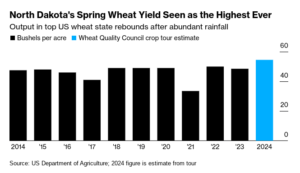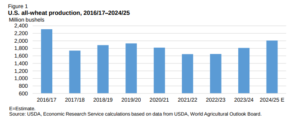Agriculture Secretary Brooke Rollins said on Tuesday that the Trump administration will announce a 'bridge payment' for farmers next week that is designed to provide short-term relief while longer trade…
US Wheat Yields Up Significantly Over 2023
Bloomberg’s Michael Hirtzer reported that “record-high wheat yields in North Dakota are set to further expand American grain supplies and should help to quell inflation for foods like bagels, where prices had recently started rising again.”
“Dozens of wheat traders, millers and bakers fanned out across the state in an annual crop tour this week,” Hirtzer reported. “They found lush wheat fields — thick with tall, green plants. Farmers enjoyed a speedy spring sowing season and ample rainfall in May and June, before a recent turn to hot and dry weather.”
“The primary variety grown in the state of hard red spring wheat should yield 54.5 bushels per acre, according to the tour’s final data Thursday,” Hirtzer reported. “That’s up 15% from last year and just below the US Department of Agriculture’s projection earlier this month of 56 bushels per acre — the highest ever. The tour estimate would also mean the state’s highest yield ever.”

USDA Predicts Largest All Wheat Production Since 2016/17
The USDA’s Andrew Sowell wrote in the July Wheat Outlook report that “U.S. all-wheat production for 2024/25 is forecast at 2,008 million bushels, the largest wheat crop since 2016/17. Production is up 134 million bushels from the previous month and 11 percent higher than the previous year.”
“Larger production for Hard Red Winter (HRW) and Hard Red Spring (HRS) are the major factors driving the year-to-year increase in total wheat production, while smaller increases are seen for White and Durum. Soft Red Winter (SRW) is down from the previous year’s bumper crop,” Sowell wrote. “Stronger U.S. supplies this year are expected to make U.S. wheat more competitive on the global market, contributing to higher exports. Total U.S. exports are forecast at 825 million bushels, the largest since 2020/21.”

Kansas Wheat Tour Also Shows High Yields
Progressive Farmer’s Jason Jenkins reported that “the Wheat Quality Council’s Hard Winter Wheat Tour concluded Thursday, May 16, in Manhattan, Kansas. After three days, scouting 449 fields across the state and some into neighboring Nebraska and Oklahoma, the total weighted average yield for hard winter wheat was estimated at 46.5 bushels per acre (bpa), a 55% increase from 2023.”
“Last year, the average yield estimate for the 2023 winter wheat tour was 30.0 bpa,” Jenkins reported. “Based on May 1 conditions, Kansas’s 2024 winter wheat crop is forecast at 268 million bushels, up 33% from last year’s crop, according to USDA National Agricultural Statistics Service. Average yield is forecast at 38.0 bpa, up 3 bushels from last year.”
How Higher Estimated Production is Affecting Markets
Hirtzer reported that “plentiful US supplies have benchmark Chicago futures trading near the lowest levels since 2020. Bigger stockpiles and cheaper grain are welcomed by food manufacturers who had been struggling with years of reduced US plantings and the record-high prices that followed Russia’s invasion of Ukraine in 2022. Just a year ago, wheat was coming to the US from Poland to make up for a shortfall.”
“Still, prices for foods made from the staple grain are still relatively expensive. Earlier in July, the US Labor Department said its food index climbed amid gains in the baked-goods category even as broader inflation pressures were easing,” Hirtzer reported. “Wheat growers are also facing lower farm-gate prices even as costs for seeds, chemicals and equipment have stayed high.”





